Archivo de noticias y eventos
601 - 650 de un total de 1805
También puede acceder a la lista de noticias publicadas en los medios relacionadas con el Instituto de Astrofísica de Andalucía - CSIC.
Pages

|
16/03/2017 - 12:30
Space astrometry: the Hipparcos and Gaia missions The talk will provide a short historical context and describe the scientific motivation for these missions, outline the essential experimental principles which underpin their measurements, and give an overview of the science objectives, including Gaia's expected yield of many thousands of astrometrically-detected exoplanets. Prof. M. Perryman |

|
30/03/2017 - 12:30
Star formation in nearby early-type galaxies It is well known that there is little star formation activity in early-type galaxies. By cross-matching SDSS DR 7 with RC3 catalog and visually checking the SDSS images, we derive a sample of 583 S0 galaxies with the central spectrophotometric information. In order to separate nebular emission lines from the underlying stellar contribution, we fit the stellar population model to the SDSS spectra of these S0 galaxies. According to the BPT diagram... Dr. Qiusheng Gu |
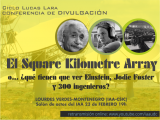
|
23/02/2017 - 19:00
El Square Kilometre Array. O... ¿qué tienen que ver Einstein, Jodie Foster y 300 ingenieros? Próxima conferencia de divulgación del ciclo Lucas Lara Lourdes Verdes-Montenegro |

|
02/03/2017 - 12:00
Supermassive Black Holes: Impact on Galaxy Formation and Evolution Supermassive black holes, weighing between millions to billions times the mass of the Sun, are believed to power quasars and other energetic activity in the centers of galaxies. With the help of advanced telescopes from the ground and in space, operating across the electromagnetic spectrum, astronomers have now discovered that supermassive black holes not only exist, but that they are very common and play a critical role in the formation and... Prof. Luis Ho |
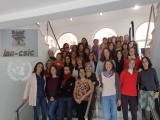
|
09/02/2017
11 de febrero. Día internacional de la mujer y la niña en la ciencia El 11 de febrero, por decisión de la Asamblea General de las Naciones Unidas, se celebra el Día Internacional de la Mujer y la Niña en la Ciencia. |

|
09/03/2017 - 12:30
Recovering information beyond the power spectrum of large-scale structure Future galaxy surveys of the large-scale structure in the Universe will provide a wealth of new data and make it possible to use higher-order statistics beyond the power spectrum, such as the bispectrum (or 3-point correlation function), to constrain galaxy clustering, the standard LCDM cosmology, and many of its possible extensions. However, it may be possible and preferable to use recently devised alternative statistics, such as the line... Dr. Joyce Byun |

|
23/02/2017 - 12:30
The impact of environment and confusion of the observed HI galaxy population The HI galaxy mass function represents a fundamental component of our understanding of the gas content of galaxies. How its form varies throughout the local Universe and as a function of redshift is key to developing a complete picture of galaxy evolution. We use the ALFALFA 70% catalogue, the largest uniform catalogue of extragalactic HI sources to date, to explore the environmental dependence of the HI mass function based on the projected... Michael Jones |
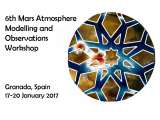
|
17/01/2017 - 20/01/2017
Mars Atmosphere Modelling and Observation Granada |
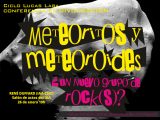
|
26/01/2017 - 19:00
Meteoritos y meteoroides: ¿un nuevo grupo de rock(s)? En esta charla voy a comunicar los últimos conocimientos de los que disponemos sobre los meteoritos y los meteoroides y su relación con los asteroides. René Duffard |

|
12/01/2017 - 12:00
Calar Alto, presente y futuro Esta charla pretende dar una visión general del estado actual del observatorio de Calar Alto mostrando los principales hitos conseguidos en los últimos años. La re-apertura de instalaciones, la concesión de nuevas ayudas del MINECO para mejoras de infraestructuras y la celebración del workshop de instrumentación en Granada, ha abierto un nuevo escenario que el observatorio va a afrontar en los próximos años. Dr. Jesús Aceituno, director de CAHA |

|
09/02/2017 - 12:30
Molecular gas and dust in low-metallicity starbursts Metal-poor, star-forming, dwarf galaxies play a fundamental role in galaxy formation and evolution, and according to LambdaCDM models may be the building blocks of most of the galaxies in the universe today. Although the interstellar medium (ISM) in such galaxies was thought to be virtually dust-free, over the last decade, observations have shown that dust can be an important constituent of even a low-metallicity ISM. However, the molecular... Dr. Leslie Hunt |

|
16/02/2017 - 12:30
Cold plasma and magnetic reconnection at the magnetopause boundary layer Magnetic reconnection is a fundamental plasma process that permits the exchange of energy and mass between colliding plasmas, e.g., between the Solar Wind and the Earth's magnetosphere. Several studies have reported the presence of cold plasma of ionospheric origin at the magnetospheric side of the magnetopause boundary layer. As a result, the particle distribution functions involved in reconnection are far from equilibrium, exhibiting a cold... Dr. Sergio Toledo Redondo |

|
02/02/2017 - 12:00
Living on the Edge: Superthin Galaxies and the Cosmic UV Background Superthin galaxies are bulgeless, late-type spiral galaxies seen edge-on. HI synthesis observations probe the kinematic structure of their interstellar medium. Observations of these isolated, quiescent galaxies have reached column densities as low as few x 1018 atoms . cm-2 . The simple structure of the superthins makes them ideal cosmological laboratories (Uson and Matthews, Astron. J. 125, 2455, 2003). I shall present the results of high-... Prof. Juan Usón |
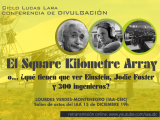
|
15/12/2016 - 19:00
El Square Kilometre Array. O... ¿qué tienen que ver Einstein, Jodie Foster y 300 ingenieros? Próxima conferencia de divulgación del ciclo Lucas Lara Lourdes Verdes-Montenegro |
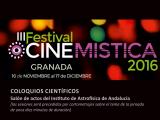
|
24/11/2016 - 11:15
Azar y complejidad (coloquio en el marco del festival Cinemística) Parece que el azar juega un papel esencial a la hora de que en un sistema se generen estructuras complejas. ¿Qué se entiende por sistemas complejos?, ¿hay un aumento de complejidad en la naturaleza con el tiempo?, ¿puede un sistema determinista generar complejidad? Enrique Pérez (astrofísico), Enrique Iáñez (biólogo) y Juan Manuel García Ruiz (geólogo) |

|
28/11/2016
II Jornadas de divulgación inclusiva de la ciencia Un foro de encuentro para mostrar los proyectos de divulgación de la ciencia más inclusivos, compartir estrategias de enseñanza accesible, mostrar materiales y recursos que hagan los contenidos accesibles para todos y dar voz a científicos discapacitados que quieran compartir su experiencia investigadora |

|
31/01/2017 - 12:30
Asteroid surfaces: irradiation and VIS-IR micro-spectroscopy in the laboratory Primitive extraterrestrial materials, such as meteorites and dust collected by sample return missions, are characterized by a large compositional heterogeneity at different scales. This heterogeneity has been observed in the laboratory by different techniques. Among these, micro-IR spectroscopy has the advantage of being totally non-destructive and allowing direct comparison with astronomical observations. With the development of Focal Plan... Dr. Rosario Brunetto |

|
26/01/2017 - 12:30
Novae as Lithium factories in the Milky Way The abundance of Lithium observed in very young stellar populations is ~4 times larger than the primordial one estimated by recent Planck measurements. Since Lithium is easily destroyed in stellar interiors, the search for astrophysical sources responsible for of the observed Lithium over-abundance was a mystery for decades. In this seminar I'll discuss the recent detection of Lithium in the spectra of two slow novae, V1369 Cen and V5668 Sgr,... Dr. Luca Izzo |

|
19/01/2017 - 12:30
Witnessing the birth of a planetary nebula Planetary nebulae are one of the last stages of evolution of stars like our Sun. The beginning of photoionization, giving rise to a new planetary nebula, will certainly produce dramatic changes in the object, but this instant is difficult to observe, since it will only take a few decades. During of a long-time study of water masers in post-AGB stars and planetary nebulae, we identified an object (IRAS 15103-5754) in which we believe... Dr. Jose Francisco Gómez |

|
01/12/2016 - 12:30
History of solar activity recorded in polar ice Un equipo de investigación internacional en el que participa el conferenciante ha reconstruido la actividad magnética solar de los últimos diez mil años analizando para ello la concentración de isótopos cosmogénicos. Dr. Antonio Ferriz |

|
02/12/2016 - 12:30
Multiwavelength analysis of PBC J2333.9-2343 Nuclear activity as is observed in active galactic nuclei (AGN) might be a phase occurring in all galaxies, and this activity could be recurrent. A perfect laboratory to test these scenarios are the giant radio galaxies, since their emission can be as old as 10⁷-10⁸ years. In the present work we focus on the nucleus of PBC J2333.9-2343, which called our attention because it is a giant radio galaxy that shows different and incompatible... Dr. Lorena Hernández García |

|
24/11/2016 - 12:30
Big Data at the IAA: main ideas and how to run a real application at the IAA computation cluster A brief description of the Big Data paradigm is presented minimizing the technical details, reviewing previous work at IAA and showing a practical case demonstration. Dr. Rafael Morales |
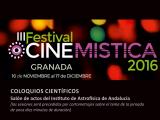
|
14/11/2016
Sesiones de divulgación sobre el azar en la ciencia Cinemística. Sesiones de divulgación sobre el azar en la ciencia |

|
17/11/2016 - 12:30
The CaII triplet in Quasars: from the accretion disk to the star formation Active galactic nuclei (AGN) show a great diversity of optical and UV emission line properties. Dynamical and physical models should be built accordingly. The presence of strong FeII emission suggested the existence of a region shielded from high energy photons, where the low ionization lines are emitted. Mary Loli Martínez Aldama |

|
10/11/2016 - 12:30
Very High Energy gamma rays from AGNs: key for AGN structure and cosmological studies The key for AGN structure and cosmological studies. Dr. Josefa Becerra |
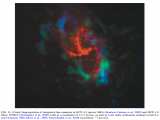
|
09/11/2016 - 12:00
Star Formation Close to and Accretion onto the Supermassive Black Hole Sgr A* The environment of Sgr A* provides a window to the close-up study of star formation under extreme physical conditions Prof. Farhad Yusef-Zadeh |

|
03/11/2016 - 12:30
A search for neutral gas outflows in nearby (U)LIRGs I will present a search for outflows in a sample of 38 local (U)LIRG systems (51 individual galaxies) observed with VIMOS/VLT and SINFONI/VLT integral field units. Dr. Sara Cazzoli |
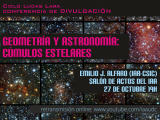
|
27/10/2016 - 19:00
Geometría y astronomía: cúmulos estelares Geometría y astronomía: cúmulos estelares Emilio J. Alfaro |

|
24/10/2016 - 12:30
RadioAstron observations in the jet in 0836+710 Space VLBI observations with RadioAstron provide an extraordinary improvement of angular resolution. Laura Vega |

|
20/10/2016 - 12:30
The Unfied Model for AGN 30 years after, and recent support for an Evolutionary Model of AGN I shall comment on the difficulties faced today by the so called "Unified Model" (UM) for AGN. Prof. Deborah Dultzin Kessler |

|
19/10/2016
La 2 estrena el documental sobre UPWARDS, un proyecto para el estudio de Marte encabezado por el Instituto de Astrofísica de Andalucía La emisión, que tendrá lugar hoy miércoles 19 de octubre a las 18h, coincide con la entrada en órbita en torno a Marte del módulo TGO y el "amartizaje" del módulo Schiaparelli, ambos de la misión ExoMars (ESA) |

|
13/10/2016 - 14/10/2016
New Instrumentation and Legacy Projects for Calar Alto Granada |

|
04/10/2016 - 12:30
The VIMOS Ultra Deep Survey: galaxy formation and evolution, 13Gyr back in cosmic time The first phases of galaxy formation and evolution remain poorly understood and improved observational constraints are needed to test the theoretical picture and simulations. I will present the results from the VIMOS Ultra-Deep Survey (VUDS) Prof. Olivier Lefevre |

|
29/09/2016 - 12:30
Presentation of the HETH group (High Energy Transients and their Hosts) HETH (High Energy Transients and their Hosts) is one of the youngest groups at IAA, founded in 2012, and belongs to both the extragalactic and stellar department. Thanks to recent success in funding applications, both by the group and by external researchers, HETH has now grown to a group of 7 young researchers. Dr. Cristina Thöne |

|
19/09/2016
Visita de la Delegación de Medio Ambiente de la Junta de Andalucía al Observatorio de Sierra Nevada La visita se enmarca en un reciente acuerdo de colaboración para mejorar la calidad del cielo |

|
15/09/2016 - 12:30
Proxima b: What could I say you already do not know about it? This august, we have published clear evidence of a planet orbiting the nearest star to Earth, Proxima Centauri, at a distance of 1.295 parsecs (4.2 ly) and one of the best-studied low-mass star. Dr. Pedro Amado |

|
22/09/2016 - 12:30
Delving into the gas-phase of CALIFA galaxies to trace O and N gradients CALIFA (Calar Alto Legacy Integral Field Area survey) has provided spatially resolved optical spectra of thousands of HII regions in spiral galaxies of the Local Universe whose properties can be linked with the integrated properties of the host galaxies... Dr. Enrique Pérez Montero |
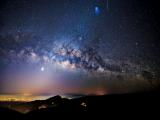
|
27/06/2016
El IAA acoge una jornada sobre la calidad del cielo El cielo oscuro como patrimonio o la lucha contra la contaminación lumínica constituirán algunos de los ejes de la sesión. La jornada busca crear un espacio de encuentro donde los distintos agentes implicados en la protección del cielo andaluz intercambiarán conocimiento, perspectivas y experiencias |

|
23/06/2016 - 12:30
Using the local gas-phase oxygen abundances to explore a metallicity-dependence in SNe~Ia luminosities In this talk I present an analysis of the gas-phase oxygen abundances of a sample of 28 galaxies in the local Universe (z<0.02) hosting Type Ia Supernovae (SNe Ia). The data were obtained with the 4.2m William Herschel Telescope (WHT). Manuel Moreno Raya |

|
16/06/2016 - 12:30
Space VLB interferometer RadioAstron: status and results The RadioAstron Space VLBI mission utilizes the 10-m radio telescope on-board the dedicated Spektr-R spacecraft to observe cosmic radio sources with an unprecedented angular resolution at 92, 18, 6 and 1.3 cm. Yuri Kovalev |

|
09/06/2016 - 12:30
Blazars: Order and Disorder Blazars are the most luminous persistent objects in the sky. They emit light across the entire electromagnetic spectrum, from low-energy radio waves to high-energy gamma-rays, and they exhibit variability on timescales that range from years down to minutes. The launch of the Fermi Large Area Telescope (LAT) in 2008 has ushered in a new era of high-energy astrophysics. Prof. Nicholas Macdonald |
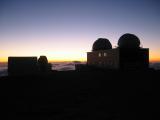
|
03/06/2016
Este verano, súbete a un observatorio El Instituto de Astrofísica de Andalucía (IAA-CSIC) y el Instituto de Radioastronomía Milimétrica (IRAM) desea brindar a los ciudadanos la posibilidad de visitar el Observatorio de Sierra Nevada y la radioantena de 30 metros durante este verano. Ya puedes apuntarte |

|
30/06/2016 - 19:00
La búsqueda de nuevas Tierras En esta charla haremos un breve viaje por algunos hitos del descubrimiento exoplanetario Cristina Rodríguez López |

|
02/06/2016 - 12:30
Star formation and AGN activity in the most luminous LINERs in the local universe In this talk I will focus on the most luminous LINERs in the local universe, where we studied their SF and AGN activity in order to understand the LINER phenomenon in relation to star-forming galaxies and to compare their properties with those of the LINERs at z ~ 0.3. Dr. Mirjana Povic |

|
30/05/2016 - 03/06/2016
Blazars through Sharp Multi-Wavelength Eyes Málaga |

|
25/05/2016 - 12:30
ECS: Diseño y construcción de Observatorios Astronómicos ECS es una empresa de ingeniería especializada en Observatorios Astronómicos. Realiza los pertinentes estudios y evaluaciones de calidad de cielo, logística y necesidades específicas, para ubicar y diseñar el observatorio. Francisco Ángel Espartero Briceño |
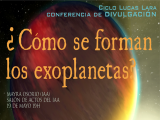
|
19/05/2016 - 19:00
¿Cómo se forman los exoplanetas? Hasta hace relativamente poco solo teníamos un ejemplo de sistema planetario, nuestro Sistema Solar, y no podía descartarse que fuera un caso excepcional. Mayra Osorio |

|
19/05/2016 - 12:30
The magnetic field vector in solar chromospheric structures: the diagnostic potential of the near infrared He I 1083nm triplet The solar chromosphere is permeated by solar structures such as sunspots, surges, flare ribbons, prominences (filaments) or spicules, where non-local thermodynamic equilibrium effects dominate the state of the plasma and where the magnetic fields are expected to be much lower in intensity than in the photosphere underneath. Dr. David Orozco |

|
11/05/2016
Estreno en la Palma de "La velocidad de nuestros pensamientos" con motivo del Día Internacional de la Astronomía El largometraje documental se estrenará el domingo 15 de mayo, un día después del día Internacional de la Astronomía el 14 de mayo en el marco de El Festivalito La Palma – Festival de Las Estrellas, dirigida por Nacho Chueca y producida por el Instituto de Astrofísica de Andalucía (CSIC) |

|
12/05/2016 - 12:30
Sgr A* and its environment: insights from X-ray observations Almost every massive galaxy has at least one super-massive black hole (SMBH) at its center. Most (>90%) of those SMBHs are quiet. Understanding the accretion of low-luminosity SMBHs represents a very important and fundamental problem in astronomy. Dr. Daniel Wang |